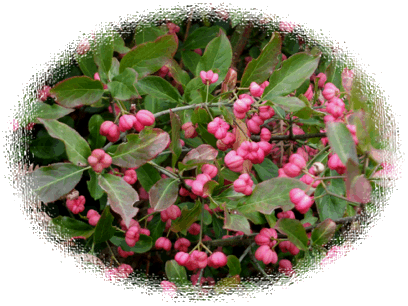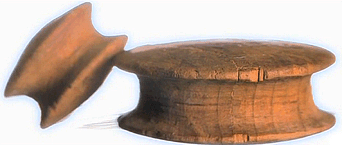
“I coulde never learne an Englishe name for it. The Duche men call it in Netherlande, spilboome, that is, spindel-tree, because they use to make spindels of it in that country, and me thynke it may be as well named in English seying we have no other name.” – William Turner.
The spindle tree, to coin a phrase, “does exactly what is says on the tin,” or other words it name derives from the common usage its wood was put to: making spindles. However that is not exactly correct as its wood and berries have been used for numerous other purposes. There are several other names the tree is known by; Skewerwood, again alluding to the wood being used as meat skewers, Prickwood, indicating its use as toothpicks and Gatter. This word comes from the old Anglo Saxon words Gad,meaning goad, Clark Hall p.46, and treow meaning tree, Clark Hall p.348, thus suggesting the wood’s use as a cattle goad.
Euonymous europaeus or the Spindle tree is a native deciduous tree that is capable of growing up to heights of six metres and can live as long as one hundred years. It flowers around May/June time when it produces clusters of four white petals and alternate stamens. These eventually turn into a four lobed pinkish fruit around October time with each lobe containing an orange coloured seed. Today on Dartmoor the Spindle is more often found in the hedgerows and shrub levels of woodlands at the lower levels.
As far as wildlife are concerned the Spindle is a veritable larder thanks to its abundance of nectar which attracts a variety of insects such as bees, hoverflies, and aphids to name but a few. Moths such as the Magpie Moth, Spindle Ermine, and the Scorched Carpet Moth along with the Holly Blue Butterfly can also be found feeding on the tree. These insects in turn provide a food source for a plethora of birds such as Blue Tits, Great Tits and Robins, all who feast on the aphids. For this very reason in some parts the tree is also known as ‘Robin’s Bread’.
As noted above, Spindle Wood is a creamy white, dense and very hard and durable type of wood which has made it ideal for a whole range of uses. Early spinners fashioned spindles for the wood and other everyday household items such as skewers, knitting needles, toothpicks and other sharp pointed tools were also made. I can remember a gypsy once calling at our house hoping to sell some clothes pegs which she said were far superior to any others as they were made from Spindle wood. It is said that if a skewer made from spindle wood is used to pierce meat then it will stop it from going rotten or at least slow down the process. I have come across a unique reference for Spindle wood written in 1850: “My wood, if cut at the time of flowering, is tough and not easily broken. The watchmaker uses it for cleaning watches, and the musical instrument makers for organ keys.”
A concoction of the fruit mixed with vinegar was produced to control psoroptic mange in cattle which can cause problems when housed over winter. However, should any of the tree be eaten by sheep, cattle and horses it can prove to be fatal, only goats can safely browse on it – now there’s a surprise. Due to the hard nature of Spindle wood it was/is ideal for making high quality charcoal which today is favoured by many artists. The fruits can also produce a yellow dye when boiled in water and should they be boiled in alum then the result is a green dye. A traditional remedy for head lice was to make and crush the berries as these have insecticidal properties. The are also other human remedies that can be produced from the tree but great care needs to be taken as all parts of the Spindle tree are highly toxic and should only be produced by experts. However, in some proprietary medicines when taken internally it can be effective against liver and gall bladder disorders. When used externally it can be used to treat abscesses, chilblains, acne and various types of wounds.

In 2007 a hedgerow survey was carried out in six Devon parishes amongst which were Hennock and Sourton. It was discovered that Spindle trees were present in 9% of the 773 hedgerows surveyed and with regards to the two Dartmoor parishes Hennock had the highest occurrence.
On Dartmoor an initiative called ‘Moor trees‘ was set up in 1999 whose purpose is to recreated native woodlands. Part of this scheme includes the planting of Spindle trees and should anyone wish they can find further details by following the link above.

The Whitehorse Hill Spindle ear studs
In 2011 an undisturbed an Early Bronze Age burial kist was discovered on Whitehorse Hill and amongst the burial goods were two sets of wooden ear studs. Following conservation work revealed that they were actually made from Spindle wood. This strongly suggests that man has been utilising Spindle wood for at least 4,000 years upon Dartmoor.

Clark Hall, J. R. 2004. A Concise Anglo-Saxon Dictionary. Canada: Cambridge University Press.
 Legendary Dartmoor The many aspects past and present of Dartmoor
Legendary Dartmoor The many aspects past and present of Dartmoor

Dear Tim!
In our forests (Voronezh, Russia) euonymus is a favorite food for red and roe deer. And in the UK, too, as well?